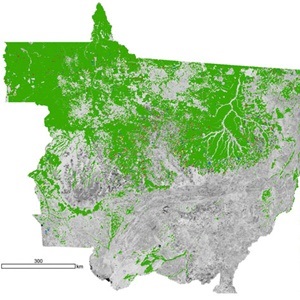
At unprecedented speed, rainforests dwindle, glaciers retreat, massive ice-shelves break off into the sea and cities threaten to engulf the last remaining scraps of wilderness. For those who still need to see the global environmental crisis to believe it, there's ample visual evidence to be found by comparing satellite images over just the last couple of decades.
Now the time lag between acts of environmental destruction like deforestation, and the images that show these happening, has speeded up dramatically as the technology has improved. Many changes can be tracked at near to real-time, making it possible to halt destructive activities before further damage is done and name and shame the culprits.
Rainforest secretly cleared for “sustainable” chocolate
One recent case highlighting the value of satellite imagery in tracking environmental wrongdoing is that of United Cacao, which secretly felled thousands of hectares of rainforest to replace it with cacao for purportedly sustainable chocolate.
Environmental news website Mongabay reported that United Cacao removed over 2 000 hectares of near-pristine, full-canopy rainforest in the Peruvian Amazon to make way for their plantations.
United Cacao claimed the area had already been cleared before they got there, but this was shown to be a lie by Global Forest Watch (GFW), an online environmental monitoring service that uses satellite images to generate interactive maps on the status of forests across the globe.
Global Forest Watch uses cutting-edge technology to detect forest loss and make the information publicly available in near real-time. The satellite images are combined with information about forests crowdsourced from on-the-ground conservation organisations and concerned citizens.
Before GFW, it could take months to analyse and share information; this can now be done in a few days, says the World Resources Institute, which convenes GFW's wide range of partners, including such heavy hitters as Google and the United Nations Environment Programme (UNEP).
IMAGE: Deforestation near Tamshiyacu, Peru - October 2012. (Credit: NASA Image.)

IMAGE: Deforestation near Tamshiyacu, Peru - August 2013. (Credit: USGS Image)

IMAGE: Deforestation near Tamshiyacu, Peru - January 2015. (Credit: Google Earth Image)

These images show deforestation near Tamshiyacu, Peru. From top to bottom: October 2012, August 2013, January 2015. In the most recent image the cleared land shows up green because it has been planted over with crops.
Keeping watch over the oceans
SkyTruth, a non-profit based in the USA, uses satellite information to track issues such as commercial fishing vessels straying into marine protected areas, and marine pollution.
In April 2010, the largest accidental oil spill in history occurred when offshore drilling rig Deepwater Horizon exploded and released millions of gallons of oil into the Gulf of Mexico. SkyTruth was the first to question British Petroleum's reports of the rate of oil spilling into the sea. With help from Florida State University, SkyTruth used satellite images of the oil spreading over the water's surface to estimate the rate of flow from the well – between five and twenty-five times more than BP claimed.

IMAGE: Oil slick from Deepwater Horizon disaster shines in the sunlight off the Mississippi Delta, May 2010. Credit: NASA Image
In 2014 SkyTruth, together with ocean conservation group Oceana and Google launched Global Fishing Watch, a data technology platform that analyses data from the Automatic Identification System (AIS) network. AIS, essentially a GPS broadcast of a ship’s location, can be used to derive information about the vessel’s activities.
In January 2015, SkyTruth's analysis of satellite data vessel helped apprehend a ship that appeared to be fishing illegally in the waters off the island nation of Palau in the Pacific Ocean. From their base in West Virginia, USA, SkyTruth alerted Palau authorities and helped guide a patrol boat to the correct location to intercept the vessel, which was found to be filled with tuna and shark fins.
Space detectives
Entrepreneurs are also seeing opportunities in satellite imagery policing. “Air and Space Evidence” a UK-based consultancy that calls itself “the first space detective agency”, was launched in 2014, to offer its services sourcing and analysing earth observation data from satellites and drones for clients to use as evidence in criminal cases.
Such cases will invariably involve environmental aspects, if not always specifically environmental crime.
As an example of the type of issue the space detectives expect to soon be dealing with, they cite a case of insurance fraud committed in the wake of Hurricane Katrina in 2005. A couple in New Orleans deliberately damaged their house to claim insurance, but they were foiled by satellite images taken immediately after the storm that showed their home intact.
As the “Ash and Space” website points out, the advantage of using modern Earth observation technologies over aerial photography is that they allow access to information for practically any location on the planet, without necessitating or requiring permission to enter or fly over an area.
This is especially valuable when it comes to following activities difficult to monitor otherwise, such as non-adherence to environmental legislation in remote areas, as well as war crimes in conflict zones.

IMAGE: Scorched earth. Huts razed after burning of a village in Dilling, Sudan, 2012. (Credit: SSP, Digital Globe)
The Satellite Sentinel Project (SSP), for example, co-founded in 2010 and supported by actor George Clooney, is using a similar approach to environmental watchdogs in order to prevent further human rights atrocities in troubled Sudan and the surrounding region. Satellite imagery, together with information from sources on the ground, is analysed for evidence of recent or pending violence such as razed villages, deployment of military vehicles and mass graves.
If a threat is identified, alerts are sent out to the media, policymakers and the public with the aim of effecting a rapid international response.
Read more:




 Publications
Publications
 Partners
Partners









